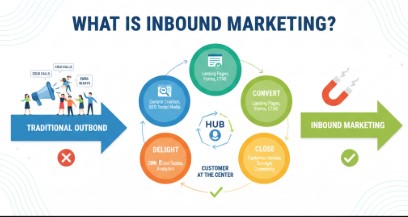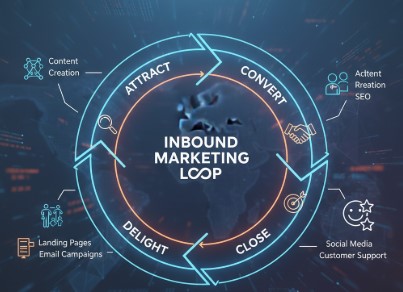Every business wants to attract new customers, but in today’s landscape, interruptive marketing tactics like cold calls and irrelevant ads just don’t cut it anymore. Instead, inbound marketing has become a powerhouse strategy for drawing customers in organically by providing them with valuable content, experiences, and solutions.
But what exactly does the inbound marketing process look like? Whether you’re just getting started or looking to refine your strategy, understanding the stages of inbound marketing is key to creating a seamless experience for your audience and driving results for your business.
This blog post will cover the four main stages of inbound marketing and how each stage works together to guide your audience from being strangers to loyal customers.
What is inbound marketing?

Inbound marketing is a methodology designed to attract, engage, and delight customers by creating valuable content and experiences tailored to their needs. Unlike traditional marketing, inbound focuses on providing help and insights, meeting customers where they are in their buyer’s journey.
By using tools like SEO, blogging, email marketing, and social media, inbound marketing transforms the way businesses connect with audiences. At its core, this strategy isn’t just about selling a product or service; it’s about solving problems and building meaningful relationships with your customers.
The four stages of inbound marketing
The inbound marketing methodology is built around four key stages that correspond to a buyer’s lifecycle. These stages are attract, engage, convert, and delight. Each stage builds upon the last, creating a customer-centric experience that fosters loyalty and growth.
1. Attract
The first stage of inbound marketing is all about drawing in the right audience. Think of this stage as casting your net to reach people who are most likely to benefit from your product or service.
Here are a few key strategies used in the attract stage:
- Search engine optimization (SEO): By targeting keywords your ideal audience is searching for, you can increase your visibility on search engines and bring potential customers to your website.
- Blogging: Consistently publishing high-quality, educational content helps establish your authority in your industry and provides value to your audience.
- Social media marketing: Use platforms like LinkedIn, Instagram, Twitter, and Facebook to share valuable content and engage directly with your audience.
- Paid ads: Strategically run pay-per-click (PPC) and social media ads to expand your reach and target specific demographics.
Why attract? A key goal here is not just to get more traffic but to ensure you’re reaching people who are truly aligned with what you offer. The right message, delivered to the right audience at the right time, sets the foundation for the rest of the inbound stages.
2. Engage
Now that you’ve attracted visitors to your site, the next stage is to turn their curiosity into interest through meaningful interactions. This stage is about actively engaging with your audience in ways that address their needs, pain points, and challenges.
Key engagement strategies include:
- Content offers: Provide valuable free resources like eBooks, whitepapers, or webinars in exchange for their contact information.
- Landing pages and lead forms: Create user-friendly landing pages that highlight the value of your offer and encourage users to sign up or learn more.
- Personalized content: Tailor your messaging (e.g., email campaigns) to align with specific audience segments, making it more relatable and relevant.
- Chatbots and live chat: Offering real-time assistance can streamline engagement and create a positive customer experience.
The goal here is to establish mutual trust by showing your audience that you understand their needs and have the right solutions. Offering valuable resources and open communications helps move them toward becoming paying customers.
3. Convert
Once a prospect has been sufficiently engaged, it’s time to turn that interest into action. The conversion stage is all about nurturing leads and helping them make an informed decision.
Some effective tactics to convert leads include:
- Email drip campaigns: Set up automated email workflows to guide leads through the decision-making process.
- Product demos or consultations: Allow prospects to see your offering in action or connect them with industry experts for a one-on-one experience.
- Case studies and testimonials: Highlighting real-world success stories can provide the social proof and confidence prospects need to move forward.
- Calls-to-action (CTAs): Use clear, compelling CTAs throughout your site and communications to prompt leads to take the next step (e.g., “Schedule a Demo” or “Start Your Free Trial”).
At this stage, you want to make it easy for your audience to take action. Provide them with the information they need in a concise, non-pushy way, and reduce any friction or barriers they may encounter.
4. Delight
Many businesses focus solely on acquiring customers, but the delight stage demonstrates the significance of keeping them happy long after the initial sale. A delighted customer doesn’t just result in retention; they can also become an advocate for your brand, driving referrals and positive reviews.
Some ways to keep your customers engaged and delighted include:
- Post-purchase follow-ups: Send thank-you emails, check in with your customers, or provide helpful resources to enhance their experience.
- Customer support: Ensuring customers have access to easily navigable support channels builds trust and creates a positive experience.
- Exclusive content: Share perks like insider tips, how-to guides, or loyalty discounts exclusively with your existing customers.
- Encourage feedback: Actively invite your audience to share their thoughts through surveys, reviews, and testimonials.
The delight stage helps to complete the cycle of inbound marketing by turning paying customers into loyal promoters who champion your business within their own communities.
Creating a continuous inbound marketing loop

The beauty of inbound marketing lies in its cyclical nature. The more customers you attract, engage, convert, and delight, the greater your opportunity to build momentum and strengthen results over time.
By continually refining your approach at each stage of the process, you can ensure your marketing efforts remain valuable, customer-focused, and impactful.
Take your inbound marketing strategy to the next level
Inbound marketing is not just about wishing for success but creating it with smart, strategic actions. Whether you’re looking to drive organic traffic, convert leads, or build lasting customer relationships, mastering the different stages of inbound marketing will propel your business toward sustainable growth.
If you’re ready to refine and enhance your inbound strategy, take the next step by contacting our team of marketing experts or accessing our latest resources to guide you further.




